Does It Hurt to Sit? The Problem May Be Piriformis Syndrome
Are you a dedicated cyclist who recently has begun to experience pain in the hip and leg area? Are you a runner, who suddenly is experiencing pain on sitting, or climbing stairs? Are you a dedicated equestrian, practiced in the art of Dressage? If any of these scenarios sounds familiar, it is possible you are suffering from piriformis syndrome. The condition can be very painful, and chronic, but it usually does respond to treatment. Apparently, the sooner treatment is begun, the better your outlook for a less painful future.
Dancing: May Lead to Trouble with the Piriformis
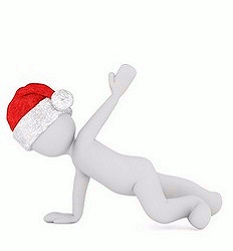
GIF constructed from multiple Pixabay images by 3D_Maenchen
After years of dancing, and not necessarily breakdancing (ballerinas get it too) your piriformis may sharply inform you of its presence and you may feel something like this:

Prolonged Sitting Can Lead to Piriformis Syndrome
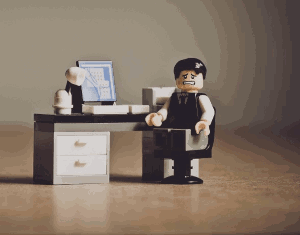
As a matter of fact, pain when sitting, or after sitting, is one of the symptoms that helps in making a differential diagnosis.
In order to understand how the piriformis can act up in so many different situations, it's a good idea to understand the neighborhood in which the piriformis resides. One of its closest neighbors is the sciatic nerve. This nerve, the longest in the human body, is a source of agony for millions. As it wends its way it stops to inflict pain randomly. One of its painful stops may be the piriformis muscle.
Composite Picture of the Sciatic Nerve From the Lumbar Spine to the Hip, and From the Hip Down Through the Leg
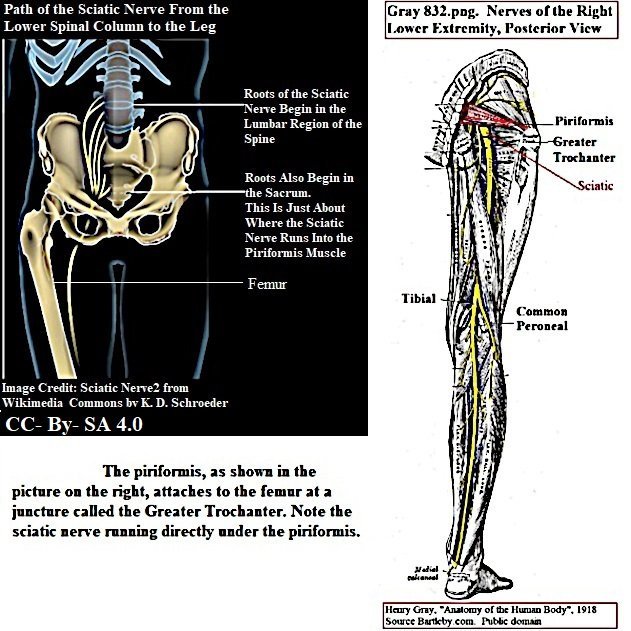
How Many Times Have You Heard People Complain of Sciatic Pain?
Look at the diagram (above). Note the number of nerve roots coming from the lumbar region of the spine, and from the sacrum. This design is a built in vulnerability. Vertebrae over time are subject to injury, and stenosis. Vertebrae thus affected often compress one of the nerve roots. When this happens, the pain is excruciating. It is also, potentially, disabling.
According to a 2007 article in the Boston Medical Journal, between 49% to 70% of all people will suffer from low back pain over their lifetimes. Of that number it is estimated that between 5% and 10% will have sciatica (that is, low back pain due to sciatica). Overall, the Journal estimates that about 2.2% of the population will experience disc-related sciatic pain every year.
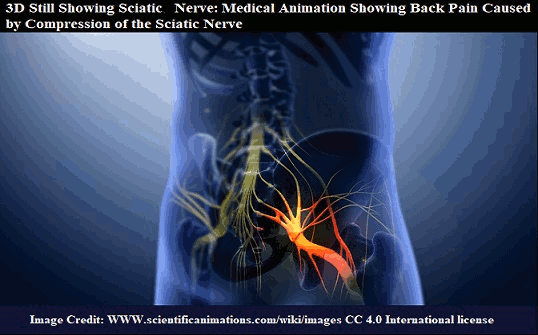
Sciatica Caused by Inflammation of the Piriformis Muscle
Although most people, and even physicians, think of sciatica as originating in the lower back, a small percentage of cases originate with inflammation of the piriformis muscle, in the hip. The piriformis is one of six muscles that help to rotate the hip externally. All six attach at the greater trochanter (see diagram above), at the top of the femur. Together these six muscles are known as the lateral rotator group.
If you're interested in learning about the exact location of these muscles, this YouTube video goes into greater detail.
Dressage: Not Good for the Piriformis
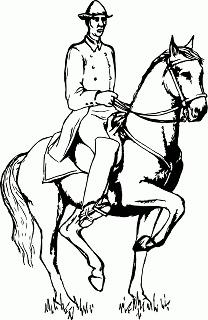
Adapted from a Pixabay vector image
The sport of dressage, which places strain on the horse because of repetitive movements, also poses injury risk to the rider. Among the rider's risks is piriformis syndrome. Ironically, the horse does not run this risk. It seems the piriformis is becoming vestigial in horses.
Relationship Between the Piriformis and Sciatic Nerve in Humans
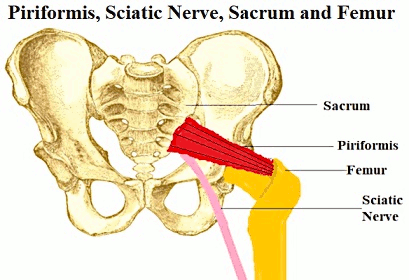
This diagram shows an inflamed piriformis impinging on the sciatic nerve. I constructed the image with a public domain illustration of the hip as a base. Using information derived from Science Direct, Piriformis Syndrome, I added the muscle, nerve and femur.
While the diagram above shows the sciatic nerve running beneath the piriformis, this is not true in all cases. In some people the sciatic nerve actually weaves through the piriformis. It is not known how often this occurs, though some estimate the number to be around 10%. It is not certain that this anatomical variation affects the risk of developing piriformis syndrome. A 2016 article in Translational Research in Anatomy suggests that the variation may be significant, and that identifying it may be helpful in deciding on a course of treatment.
Sciatic Nerve Entrapment
The difficulty with the relationship between the piriformis and the sciatic nerve arises with nerve entrapment. If the piriformis becomes inflamed, or spasms, it will impinge on the nerve. Besides being painful, this entrapment can lead to serious, long-term consequences.
Diagnosing Piriformis Syndrome
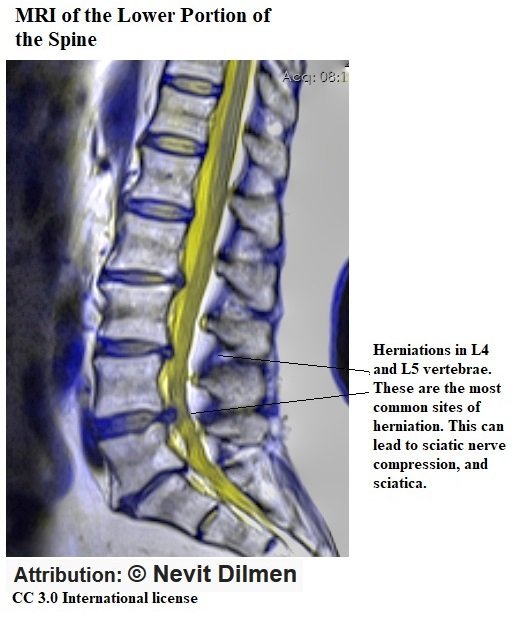 (
( )
)This is obviously not an MRI image of the piriformis. I couldn't get a public image version of that. However, this does show the lumbar region where many cases of sciatica originate. Distinguishing between sciatica that originates here and piriformis syndrome is often a challenge.
Diagnosing piriformis syndrome takes skill. As a matter of fact, there are some who suggest that piriformis syndrome is overdiagnosed, and that the issue is often merely a matter of an inflamed piriformis muscle. In order for the diagnosis to be a true piriformis syndrome, the sciatic nerve must be involved.
Physical examination of the patient is helpful, as are MRI images. A 2019 article published by the American Academy of Physical Medicine and Rehabilitation explains that diagnosis of this syndrome is difficult precisely because so many areas may be affected by inflammation of the piriformis muscle. The symptoms of the syndrome overlap with those of sciatica caused by disc compression, sacroiliac joint disease and even carcinomas that may affect nearby tissue.

Piriformis Syndrome in Dogs

Dog GIF created from Pixabay image by Cocoparisienne/.2626imagenes
Most people who have dogs as pets, particularly certain breeds, are familiar with a condition known as hip dysplasia. This can be painful, and even disabling. It seems that some cases diagnosed as hip dysplasia may actually be cases of piriformis syndrome. The location and function of the piriformis muscle in canines is remarkably similar to that in humans. In a fascinating article by Maja Guldborg, DVM, the case study of a Labrador named Iris is discussed. Iris was treated successfully for piriformis syndrome. Dr. Guldborg applied the same physical therapy remedies for Iris' condition that would be used to treat a human with piriformis syndrome.

Function of the Piriformis Muscle
The pirifomis muscle is essential to the proper rotation of the hip. It helps to stabilize the femur in the hip socket (the aetabulum).
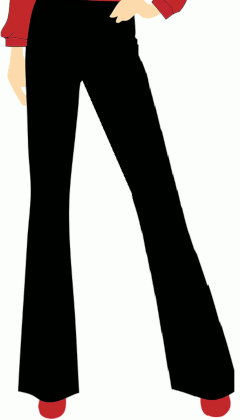
GIF constructed from a Pixabay image.
The figure in the picture demonstrates the external lateral motion that is controlled by the six external rotator muscles that attach to the femur. The piriformis is essential in this action.
Incidence of Piriformis Syndrome in the General Population
While the U. S. National Institute of Neurological Disorders and Stroke characterizes the syndrome as a "rare neuromuscular disorder",
other sources suggest it may not be so rare. A 2013 study in India attempted to assess just how common the syndrome was.
The subjects of the study, 2910 of them, all had lower back or buttock pain associated with sciatica. Age range of the patients was between 15 and 81. The study lasted two years. Results? 6.25% of the patients were found to have piriformis syndrome.
Treatment
There are several approaches toward treatment. According to an article published by Cedars-Sinai most of the treatments involve conservatively stretching and working the piriformis muscle. The most common approach is physical therapy. Application of heat is frequently recommended. Over the counter anti-inflammatory drugs are also sometimes prescribed.
There are more invasive approaches. These include injection with cortisone, and botulinum. In the most extreme cases, surgery has been tried. This last intervention of course carries the greatest risk.
Preventive Strategies
This list is short, since so many different activities can lead to the development of piriformis syndrome. Skilled advice should be sought early if you experience persistent pain in the hip and leg area. That's what the experts say. It seems like a reasonable recommendation to me.
I'll end with a lovely picture of a mouse. We owe mice so much. They endure pain and suffering to advance human health. Apparently one area of research that mice have endured involves the piriformis muscle.
Mice were used in a study that sought to find a remedy for hip dysplasia in young adults. One procedure to which the mice were subjected was detachment of the piriformis muscle.



Thank you for spending your time with me

Steem on!

Some Sources Used in Writing This Blog
(Animals in the logo image are from Pixabay)
Velo News Piriformis Syndrome and Cycling
The Daily News Running Doc: Tips for Dealing with Piriformis Syndrome
Fran Griffith The Periformis
Healthline.com *Differential Diagnosis
Inner Body Sciatic Nerve
Medscape Lumbar Spine Trauma Imaging
Mayo Clinic Spinal Stenosis Symptoms and Causes
Columbia Spine Sciatica
Boston Medical Journal Diagnosis and Treatment of Sciatica
Yoganatomy Deep Six Lateral Rotators
YouTube Hip Muscles: Lateral Rotator Group and Gluteus Maximus
Semantic Scholar Lameness in the Sport Horse
Peacelovehorses.wordpress.com Copmmon Rider Problems
mywowbb.com Dr. Deb Piriformis Muscle
Science Direct Neuroscience: Piriformis Muscle
Midwest Spine Piriformis Syndrome
Translational Research in Anatomy Anatomical variations of the sciatic nerve, in relation to the piriformis muscle
Muscle Ligaments and Tendons Journal Deep gluteal space problems: piriformis syndrome, ischiofemoral impingement and sciatic nerve release
Osteopath-west.co.uk Piriformis Syndrome or Just a Pain in the Butt
Journal of Clinical Imaging Science Diagnosis and Management of Piriformis Syndrome: A Rare Anatomic Variant Analyzed by Magnetic Resonance Imaging
American Academy of Phyiscal Medicine and Rehabilitation Piriformis Syndrome: A Narrative Review of the Anatomy, Diagnosis, and Treatment
Case Report: Is Piriformis Syndrome a Tangible Diagnosis in Animals?
https://www.sciencedirect.com/science/article/pii/B9781437709278000142
Acupuncture for Sports and Trauma Rehabilitation CHAPTER 14 - General Principles of Treating Soft Tissue Dysfunction in Sports Injuries
Wikimedia Commons Gluteus Maximus Muscle - Function, Origin & Insertion - Human Anatomy Kenhub 1.webm
Journal of the Medical Society Prevalence of piriformis syndrome among the cases of low back/buttock pain with sciatica: A prospective study*
Cedars-Sinai Piriformis Syndrome
Harvard Health. edu Ask Dr. Rob about Piriformis Synddrome
Orthopaedic Research Novel model for the induction of postnatal murine hip deformity
Wow, a brilliant article. Though I kept wondering that why sitting for long periods may cause inflammation of the muscle or around the spinal disc. Then I thought about this recent post I did on pain-sensing neurons being sufficient to induce inflammation. I checked and found some of the TRPV1+ nerve fibres that sense both pain and cause inflammation being involved in sciatic nerve injury. In fact, there are studies discussing blocking these ion channels as a potential analgesic for the treatment of pain relief in this condition. It makes me wonder that, if it is possible that chronically stressing these nerve fibres by your posture might lead to a slow accumulation of inflammation, which then ends up in a positive feedback loop of inflammation + pain -> activation of sensory fibres --> more inflammation and pain. I don't know if anyone has looked into this possibility. It would be interesting to see if type 17 immune response is what is keeping the cycle going.
Posted using Partiko Android
Thank you so much!!Brilliant from you is like climbing Mt. Everest for me in the science universe :) I started to read your article with great interest last night and then sleep overcame me. The article wasn't dull but the hour was quite late:))
I think your idea is quite sensible. I will finish that article and consider what you have discussed here. To me it is axiomatic that we must look at old problems in new ways for solutions. Amazing how many people follow the same path, year after year. Innovation and creative thinking lead to progress...that is true in art and science. I think, as poor as my background is in science, the one benefit I have is I don't know anything :) I may make mistakes, but the perspective is original. Also, my ignorance obliges me to be very, very careful when I write.
Thank you again for that uplifting and also informative comment.
Cheers, AG
My dear @agmoore2,
This is like an anatomy lesson! What an incredibly well-researched post :)
It reminded me of what my husband went trough nearly a couple of years ago. He got into playing padel. But, only after four weeks he began to feel this terrible pain down his leg. Like you said, the pain was excruciating and disabled him for nearly three months. For 4 weeks he could not even turn from one side to another on the bed, when that improved, he could not even make his way to the bathroom (It was then when I learnt how heavy 84 Kg are!). His recovery was painfully slow and for weeks after that he needed to walk with the aid of crotches.
I don't remember whether piriforms inflammation was brought up throughout his diagnosis/treatment. We were informed that both the physical therapy sessions and all the medication he needed to apply and take were targeting a sciatic nerve entrapment. For this reason I found rather interesting to read the relationship between the two.
Oh, before I forget! The illustrations you created for your article are amazing. Some of them actually help one to relate to the ache! Ouch!
Have a wonderful day my dearest friend.
Sending you lots of love with great respect from Portugal.
I hope things are less sticky over there. I woke up to a rainy morning here today. The birds and trees seemed as pleased as me :)
❤🌂
Dear, Dear Abigail,
I woke this morning to find your comment. That made me happy. 😇 Then I read about your husband's dreadful accident and the ordeal the two of you went through in order for him to heal. Terrible! 😟 What a coincidence (not a happy one!) that you have experience with sciatic nerve entrapment. I was hoping when I wrote that the article would be meaningful for someone...and it was you !!
Has your husband's injury completely resolved, or is this something that will be an issue on and off for the rest of his life? I hope not the latter.
I must admit that I just came back from my first physical therapy session. I wasn't going to mention it, but feel so good about the outcome that I will. A long-standing sciatica problem (doesn't the whole world have one?) seems to be the source of my current difficulty, which is mimicking the symptoms of piriformis syndrome. This is not acute, as your husband's was, but it is limiting.
Anyway, that's what prompted this article. I wanted to know more so I could help myself and cooperate productively with the physical therapist. I find that writing is a good way for me to learn.
Thank you for enjoying my illustrations. Blame @shaka. GIFs are a byproduct of participating in his contest. 🎨 I'm addicted. And, I find that if I draw a diagram of something, I can more clearly visualize the scheme. So glad you found that helpful, also.
Yes, I do love the rain. Not torrents, but gentle, nourishing rain. This year I planted the tiniest tree, not even a sapling. So small my daughter laughed when she saw it. Rain is that tree's best ally 🌴
Thank you so much for your encouragement and appreciation. You know, for me, that is the virtue of Steemit. The wonderful people I meet, my friends. I would never know them, would never know you, without this platform.
Have a delightful, breezy, rainy day in Portugal.
With great affection and appreciation,
From sunny, not-so-sticky, New York
Your Friend, AG❤
Good morning my dear @agmoore2 ,
Ha! What a coincidence. I am sorry to hear you have been experiencing discomfort due to sciatica problems. But it pleases me to hear you had a good session with your physio-therapist. He must be so impressed with you, with your level of understanding. 😎
My husband has been left with what is known as foot drop. This, however, has considerably improved over the past year as a result of some exercises he has been told to at home and in the swimming pool. He also still goes to the physio (considerably less frequent now). He actually has an appointment today!
I also find writing a great tool for reinforcing learning, ventilating and rationalizing emotions. Writing is beautiful, isn't? And how wonderful that we have a place like Steemit to do it and as a consequence of it get know smart, kind people. To meet friends.
I smiled at your tiny tree story. How Sweet ❤ :)
Have a beautiful day over there in NY my wonderful friend. It will be a busy one for me, and I love it. 🌞
Much love to you @agmoore, always ...
Your Brazilian Friend,
Abigail
Dear Abigail,
I'm so sorry! I looked up foot drop on the Mayo Clinic site. They say the difficulty comes from injury to the peroneal nerve, which is indicated on the diagram in my article. Swimming seems to be good for everything. Plus, it's fun and increases overall health.
I'm glad your husband is taking measures to improve his condition. It surely is a great help that he has you to encourage and support him. A positive, loving spouse is invaluable, in short and long-term challenges.
It's amazing that medicine is so advance and then it is unable to "fix" a problem like this.
I'm sending a picture of my "tree", taken shortly after it was planted. The beautiful tree in the background is my neighbor's. My daughter took the picture, I think, in order to humiliate my tiny sapling. 😅
Only an optimist would confidently plant such a fragile thing and expect it to endure the New York winter. We'll see...
I hope you and your husband have a most wonderful day. It will be the weekend at conclusion of your busy day...a little bit of punctuation in the calendar to remind us that time is precious.
From peaceful, and optimistic 😇 New York,
Your friend, AG❥
SO TRUE! 😕 But really, we can not complain. My husband has come a long way.
As for your tree ... oh Gosh @agmoore2, I was about to write how beautiful, colorful and strong it is. Then I read your comment and only then I saw the little green plant 😂 your tree may be a fragile being; but, it sure brings joy! It looks like your daughter has a great sense of humor 😃
I love, love, love trees. I think they are magnificent beings. I recently finished reading a very beautiful book about them The hidden life of trees. I feel I know them better now :) I also often draw them (although, last time I did this was 4 months ago).
There is a place near me (25 min. drive): A Floresta de Sintra (or Floresta da Peninha), it is my favourite place in the whole world. Whenever time allows, there we are. The only bad thing about going there is that we eventually have to leave.
I know you will like this place too my friend. And I will think of you next time I go there :*
Trees! I love trees. 🌲🌳 My favorite thing to draw...but only digitally because my hands do not obey me :)
I have just visited Floresta de Sintra and I will take you there
I watched several videos but liked this the best.
Thank you !!
And yes, my daughter has a great sense of humor. Grasps any opportunity to laugh and that laugh is infectious.
I wish you peace, and green vistas.
With affection,
Your NY friend, 🎔
AG
😊
Talk to my wife about the sciatic nerves. It hurts her luckily still occasionally, but quite deeply and severely. I am however quite confident, after reading your post (that is quite informative and comprehensive), that her pain is probably not related to the piriformis...
I am so sorry. I know that pain...it's a special kind of pain. When you twist your back in a certain way, the stabbing response is unforgettable. Usually it resolves for me within a week. And it visits rarely.
Yesterday I saw a physical therapist for a new kind of pain, really unpleasant and limiting, but unlike the first. Therapist explained that it was likely referred pain from the original site of injury, in the spine. I don't know. He has given me exercises to help. I think these are sensible.
Has your wife tried exercises to strengthen the muscles that support the spine? Not that I'm an expert, but it's what I've been told.
Thank you for stopping by. I really appreciate your assessment of my post. It was fun to write and also helpful, for me, personally.
She is like you. The pains stops as sudden as it appeared within days. My wife is trying to exercise herself everyday. But keeping the routine, with two young children around, is unfortunately not that easy.
I am not fully convinced exercising would be enough to fully cure the issue. Does it work in your case?
These are the exercises he gave me. They are very simple and basic. Don't see that they will hurt. Can only help. Especially the flexing of the abdominal muscles. Seems to be essential for support of the spine.
I looked these up to refresh my memory, also, so I can do them properly.
Hold for 3 seconds. Do 10X. Tighten abdominal muscles during the exercise
Pelvic tilt
Also 3 seconds, 10X, flex abdominal muscles as you do it
Pelvic tilt with ball between the knees
Hold for 3 seconds. 10X. Tighten abdominal muscles.
side-lying clam pose
3 seconds, 10x, tighten abdominal muscles as you do it
Cat stretch exercise
Child's pose.
This one he modified for me. My hands were folded under my head not stretched out in front. It was very relaxing--I could have stayed in that position for half an hour :) Hold for 30 seconds. Tighten abdominal muscles
https://www.yogabasics.com/asana/child/
Finally, he told me to rest my spine. Lie down for ten minutes, at least twice a day, on my back. I know for a mother with two young children this is a joke :))
I am once in a while doing that, after a long day. Just lying down on the floor during 10-20 seconds... I like it (especially as I stay sit for more than 10 hours a day).
This post has been voted on by the SteemSTEM curation team and voting trail. It is elligible for support from @curie and @utopian-io.
If you appreciate the work we are doing, then consider supporting our witness stem.witness. Additional witness support to the curie witness and utopian-io witness would be appreciated as well.
For additional information please join us on the SteemSTEM discord and to get to know the rest of the community!
Thanks for having added @steemstem as a beneficiary to your post. This granted you a stronger support from SteemSTEM.
Thanks for having used the steemstem.io app. You got a stronger support!
Thank you SteemSTEM!
Congratulations @agmoore2! You have completed the following achievement on the Steem blockchain and have been rewarded with new badge(s) :
You can view your badges on your Steem Board and compare to others on the Steem Ranking
If you no longer want to receive notifications, reply to this comment with the word
STOPVote for @Steemitboard as a witness to get one more award and increased upvotes!
Good post on health.